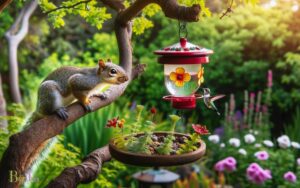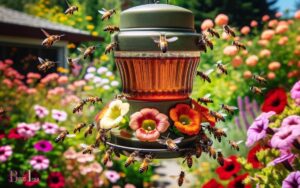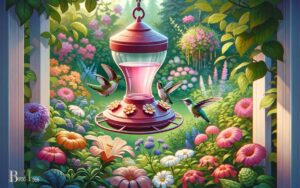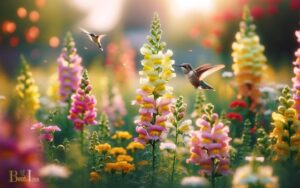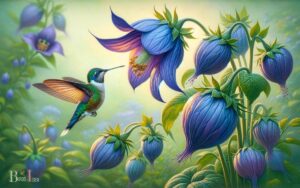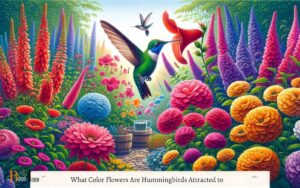Why Are Hummingbirds Attracted to Flowers? High Nectar!
Hummingbirds are particularly attracted to flowers due to their bright colors, high nectar content, and shapes that accommodate their feeding habits.
The vibrant hues of flowers, especially reds and pinks, are highly visible to hummingbirds, who have good color vision. These colors often signal a rich source of nectar, which is essential for the birds’ high metabolism.
Additionally, the tubular shapes of many flowers are ideal for the long, slender beaks of hummingbirds, facilitating efficient feeding and pollination.
Hummingbirds and flowers have a mutualistic relationship where both parties benefit. This relationship has driven the co-evolution of both species, leading to the development of certain flower characteristics that cater specifically to hummingbirds. These include:
The interplay between hummingbirds and flowers exemplifies nature’s complexity and the beauty of evolutionary adaptation.
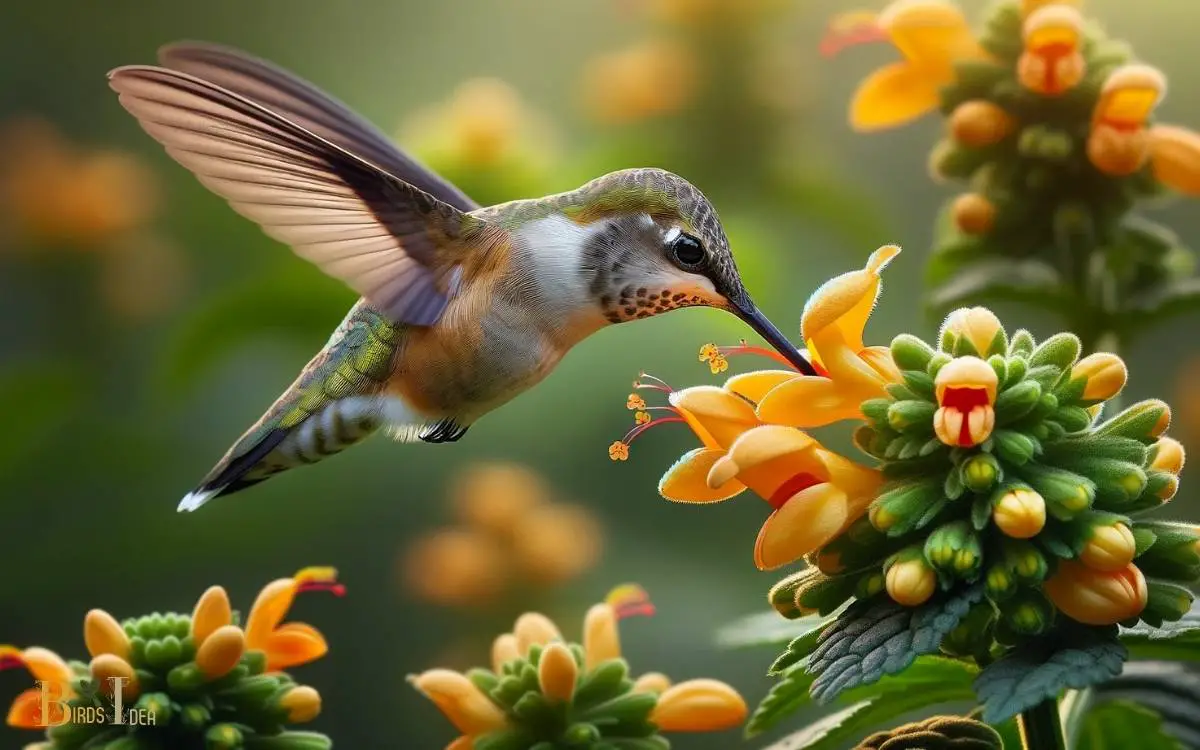
Key Takeaway
4 Features: Hummingbirds Prefer Certain Flowers
| Feature | Significance for Hummingbirds | Examples of Flowers |
|---|---|---|
| Bright Colors | Visual attraction, signaling nectar-rich sources | Petunias, bee balm, zinnias |
| High Nectar Content | Nutritional needs for high metabolism | Trumpet vine, cardinal flower, honeysuckle |
| Tubular Flower Shape | Accommodate beak and tongue for feeding | Fuchsia, columbine, penstemon |
| Minimal or No Scent | Hummingbirds are less reliant on smell, preferring visual cues | Coral bells, impatiens, lupines |
Hummingbirds’ Visual Acuity
Hummingbirds are able to detect and distinguish colors with exceptional precision, allowing them to locate nectar-rich flowers efficiently.
Their visual acuity is remarkable, as they are tetrachromatic, meaning they have four types of cones in their eyes that enable them to perceive a wide range of colors, including ultraviolet light.
This gives them an advantage when foraging for food, as they can easily spot the colorful, tubular-shaped flowers that hold high-energy nectar. Their ability to see in the ultraviolet spectrum also helps them identify which flowers are likely to provide the most nectar.
With this heightened visual perception, hummingbirds can swiftly navigate through dense vegetation to find the most rewarding sources of nectar, contributing to their survival and unique role as pollinators.
Flower Nectar as Energy Source
Their remarkable visual acuity allows hummingbirds to efficiently locate and extract nectar from flowers, utilizing the flower’s nectar as an essential energy source for their high metabolic needs.
Flower nectar is primarily composed of sucrose, glucose, and fructose, providing the necessary carbohydrates for hummingbirds’ energy demands.
As these tiny birds have an incredibly fast metabolism, they need to consume large amounts of nectar to fuel their activities, such as hovering and rapid flight.
The high sugar content in nectar serves as a quick energy source, enabling hummingbirds to maintain their intense levels of activity. Additionally, the nectar’s energy-rich properties are vital for supporting their long migration journeys.
Ultimately, flower nectar plays a crucial role in sustaining the extraordinary energy requirements of hummingbirds, allowing them to thrive and contribute to their ecosystem.
Co-evolution of Flowers and Hummingbirds
The co-evolution of flowers and hummingbirds has resulted in a mutually beneficial relationship that has shaped the unique characteristics of both species.
Through this process, flowers have developed specific traits to attract hummingbirds, while the birds have adapted to efficiently feed on the nectar.
This co-evolution has led to several key developments:
- Flower Coloration: Flowers have evolved to display vibrant colors, particularly in shades of red, orange, and pink, which are highly attractive to hummingbirds.
- Tubular Shape: Many flowers have developed long, tubular shapes to accommodate the hummingbird’s long, specialized beak for feeding.
- High Energy Nectar: The nectar produced by these flowers is rich in energy, providing the necessary fuel for the high metabolism of hummingbirds.
- Symbiotic Relationship: Both species rely on each other for survival, forming a delicate but essential ecological balance.
Attraction to Brightly-Colored Flowers
Continuing from the previous subtopic, an examination of the evolutionary relationship between flowers and hummingbirds reveals the significance of brightly-colored blooms in attracting these avian pollinators.
Hummingbirds have excellent color vision, with a particular affinity for red, orange, and pink hues. Brightly-colored flowers signal a high nectar reward, serving as a visual cue for the energy-rich sustenance that hummingbirds seek.
This preference is rooted in the co-evolutionary history of these species, where flowers adapted to attract specific pollinators, and hummingbirds developed traits to efficiently feed from these blooms.
The vibrant colors also aid in long-distance recognition, allowing hummingbirds to spot potential food sources from afar.
As a result, the mutualistic relationship between hummingbirds and brightly-colored flowers has driven the evolution of both, emphasizing the crucial role of color in attracting these remarkable avian pollinators.
Importance of Flower Shape and Size
One key aspect of the attraction of hummingbirds to flowers is the variety of shapes and sizes that blooms exhibit.
The importance of flower shape and size in attracting hummingbirds includes:
- Tubular Flowers: These are well-suited for the long, slender bills of hummingbirds, allowing them to easily access nectar.
- Open-faced Flowers: These provide a platform for hummingbirds to perch and feed, making it easier for them to access nectar.
- Red or Orange Flowers: These colors are frequently associated with tubular or bell-shaped blooms that attract hummingbirds due to their keen color perception.
- Large Flowers: These are easier for hummingbirds to spot from a distance, making them more likely to investigate and feed from the blooms.
Understanding the significance of flower shape and size can help in creating a hummingbird-friendly garden.
Role of Scent in Hummingbird Attraction
Scent plays a crucial role in further enhancing the appeal of flowers to hummingbirds, as it provides an additional sensory cue for the birds to locate and identify potential nectar sources.
Hummingbirds have an excellent sense of smell, and they are attracted to the fragrances emitted by flowers. The scent of a flower can signal the presence of nectar from a distance, guiding hummingbirds to the food they need for energy.
Additionally, some flowers emit scents that are especially attractive to hummingbirds, further increasing their appeal.
The role of scent in hummingbird attraction is significant, as it complements other visual cues and helps hummingbirds efficiently locate and feed from flowers.
This sensory aspect of scent adds another layer of fascination to the intricate relationship between hummingbirds and flowers.
Seasonal Flower Availability
Seasonal flower availability influences the range of nectar sources accessible to hummingbirds throughout the year, affecting their foraging patterns and feeding behaviors.
- Hummingbirds rely on a variety of flowers for nectar, and the availability of specific flowers changes with the seasons.
- Different flower species bloom at different times of the year, providing a diverse array of nectar sources for hummingbirds.
- Spring and summer offer an abundance of flowers, while the fall and winter months may have limited flowering plants.
- Hummingbirds may need to adjust their foraging locations and behaviors in response to the changing availability of flowers.
This variation in flower availability directly impacts the nectar options for hummingbirds, influencing their movement and feeding habits as they seek out the most abundant nectar sources throughout the year.
Why Am I not Attracting Hummingbirds
Attracting hummingbirds to your garden can depend on several factors.
Here are some common reasons why you might not be attracting hummingbirds:
- Lack of Suitable Flowers: Hummingbirds are attracted to brightly colored flowers with tubular shapes, such as trumpet vine, salvia, bee balm, and fuchsia. If your garden doesn’t have these types of flowers, hummingbirds may not find it appealing.
- Insufficient Food Sources: Hummingbirds primarily feed on nectar from flowers, but they also eat insects for protein. Ensure there are enough nectar-producing flowers in your garden to sustain them.
- Lack of Shelter: Hummingbirds need shelter to rest and nest. Trees, shrubs, and other vegetation provide cover and protection from predators. If your garden lacks sufficient vegetation, hummingbirds may not feel safe and may be less likely to visit.
- Presence of Predators: Hummingbirds are preyed upon by larger birds, cats, and other animals. If there are many predators in your area, hummingbirds may avoid your garden.
- Chemical Use: Pesticides and herbicides can be harmful to hummingbirds and the insects they rely on for food. If you use chemicals in your garden, it could deter hummingbirds from visiting.
- Lack of Water: Hummingbirds need water for drinking and bathing. Adding a shallow bird bath or misting fountain to your garden can attract them.
- Geographical Location and Migration Patterns: Depending on your location, hummingbirds may only be present during certain times of the year due to migration patterns.
- Patience: Sometimes it just takes time for hummingbirds to discover your garden. Keep providing food, shelter, and water, and eventually, they may find their way to your garden.
By addressing these factors, you can increase the likelihood of attracting hummingbirds to your garden.
Conclusion
Hummingbirds are attracted to flowers due to their visual acuity, the energy source of flower nectar, and the co-evolution of flowers and hummingbirds.
They are drawn to brightly-colored flowers, and the shape, size, and scent of the flowers also play a crucial role in their attraction. As the seasons change, so does the availability of flowers, creating a beautiful dance of nature’s harmony.
Like a delicate waltz, the relationship between hummingbirds and flowers is a graceful and intricate partnership.

